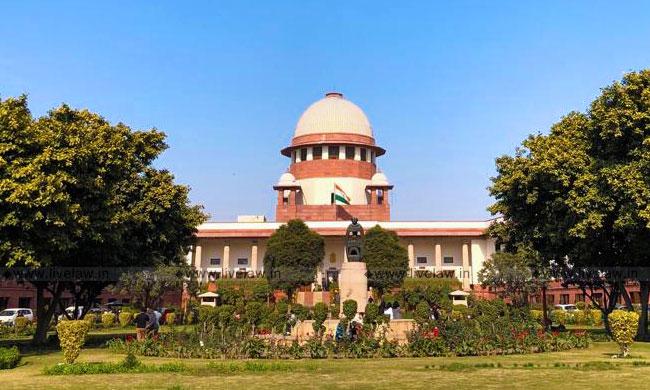Recovery Based on Coerced Confession is Illegal: Supreme Court

Image Coutesy: Live Law
If recovery of allegedly incriminating articles is based on a confession which has been extracted through custodial torture and has no value in the eyes of the law, then conviction premised upon the recovery of incriminating articles pursuant to such a confession is not valid in law, the Supreme Court has recently held.
The January 14 ruling, delivered by a bench of Justices Mohan Shantanagoudar and NV Ramana, comes in the case of Ashish Jain , three of whose relatives were murdered after an alleged robbery. By a 2:1 majority, the high court overturned the trial court’s conviction and acquitted all the accused. Ashish, a nephew of the moneylender who was killed, went on appeal to the apex court.
The police and prosecution claimed that the accused were arrested on the basis of statements made by relatives of the deceased, and that based on their confessions, recovery of the incriminating articles were made the very next day.
However, both the apex court and the high court found glaring loopholes in the FIR and the statements of three prosecution witnesses who claimed to have seen the accused exit the scene of the crime. The forensic evidence was patchy and did not meet the standards required by the law, so ultimately the conviction hinged on the “last seen evidence” and the recovery of incriminating articles. On first count, the testimonies of the witnesses were found to be unsatisfactory and unreliable by both the appellate courts, and the confessions were found to have been extracted under duress.
Relationship between Article 20(3) and Section 27, Evidence Act
Although confessions in police custody are inadmissible in evidence (vide Sections 25 and 26 of the Evidence Act), Section 27 is an exception since it allows taking on board the evidence of recovery of incriminating articles based on confessions, even if they were given in police custody. However, this does not mean that the Section allows the protection against self-incrimination (guaranteed as a fundamental right by Article 20(3) of the Constitution.
In its ruling, the apex court bench focused on this aspect.
It said :
“We find from the totality of facts and circumstances that the confessions that led to the recovery of the incriminating material were not voluntary, but caused by inducement, pressure or coercion. Once a confessional statement of the accused on facts is found to be involuntary, it is hit by Article 20(3) of the Constitution, rendering such a confession inadmissible. There is an embargo on accepting self-incriminatory evidence, but if it leads to the recovery of material objects in relation to a crime, it is most often taken to hold evidentiary value as per the circumstances of each case. However, if such a statement is made under undue pressure and compulsion from the investigating officer, as in the present matter, the evidentiary value of such a statement leading to the recovery is nullified.”
Quoting affirmatively from the three-judge bench of the apex court’s ruling in Selvi v State of Karnataka, the judges said:
provision permits the derivative use of custodial statements in the ordinary course of events.
In Indian law, there is no automatic presumption that the custodial statements have been extracted through compulsion. In short, there is no requirement of additional diligence akin to the administration of Miranda [16 L Ed 2d 694 : 384 US 436 (1965)] warnings. However, in circumstances where it is shown that a person was indeed compelled to make statements while in custody, relying on such testimony as well as its derivative use will offend Article 20(3).”
Thereafter, going by the Constitution Bench ruling in the Kathi Kalu Oghad (1961) case, the judges said :
“The relationship between Section 27 of the Evidence Act and Article 20(3) of the Constitution was clarified in Kathi Kalu Oghad [AIR 1961 SC 1808 : (1961) 2 Cri LJ 856 : (1962) 3 SCR 10]. It was observed in the majority opinion by Jagannadhadas, J., at SCR pp. 3334: (AIR pp. 181516,para 13) 13. … The information given by an accused person to a police officer leading to the discovery of a fact which may or may not prove incriminatory has been made admissible in evidence by that section. If it is not incriminatory of the person giving the information, the question does not arise.
It can arise only when it is of an incriminatory character so far as the giver of the information is concerned. If the self-incriminatory information has been given by an accused person without any threat, that will be admissible in evidence and that will not be hit by the provisions of clause (3) of Article 20 of the Constitution for the reason that there has been no compulsion. It must, therefore, be held that the provisions of Section 27 of the Evidence Act are not within the prohibition aforesaid, unless compulsion [has] been used in obtaining the information.”
Bulwark Against Police Impunity
A plethora of reports by both government agencies and civil society organisations over the years has proved that custodial torture is endemic in India. In fact, in its 273rd report (2017), the Law Commission of India, shocked at the proliferation of custodial torture, recommended that those state agents -- policemen, military and paramilitary personnel – who were accused of custodial torture – should be criminally prosecuted instead of facing just administrative action.
The Supreme Court, hearing a PIL filed by Congress leader and former minister Ashwani Kumar, had taken note of the Law Commission’s report and had said that the government should take necessary steps of ratifying the UN Convention Against Torture. The latest statistics are more shocking.
In a report prepared by the Asian Centre for Human Rights, released in June last year, it has come to light that a total of 1,674 custodial deaths, including 1,530 deaths in judicial custody and 144 deaths in police custody, took place from April 1, 2017, to February 28, 2018, as per figures placed by the Ministry of Home Affairs before the Rajya Sabha on March 14, 2018.
“This implies 1,674 deaths in 334 days (11 months), i.e. over five custodial deaths per day on an average during 2017-2018. This constitutes a significant increase in the number of custodial deaths as a total of 14,231 custodial deaths ie about four custodial death per day on an average were reported during 2001 to 2010”, the report states.
In such circumstances, the present ruling will hopefully go a long way in preventing custodial excesses by the police, since the men in khaki know that it will not work in court where it finally matters.
The writer is an independent journalist based in Delhi, and specialises in reporting on legal, human rights and gender issues. He tweets @SauravDatta29. The views are personal.
Get the latest reports & analysis with people's perspective on Protests, movements & deep analytical videos, discussions of the current affairs in your Telegram app. Subscribe to NewsClick's Telegram channel & get Real-Time updates on stories, as they get published on our website.
























